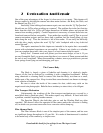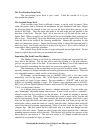Download this book for free at http://www.TheArgusA.com/
44
glue it EXACTLY where it broke off. Serious problems will occur if the Pressure Plate
is not affixed correctly.
The post-war A2B and the FA have a floating Pressure Plate (see Fig. 4-7). This
is a stamped aluminum plate that is kept aloft with by a springy metal band. The only
problem to be had with a floating Pressure Plate is a weak spring, but this can be fixed by
carefully bending the metal band with a pair of needle-nose pliers.
Both the fixed and the floating Pressure Plate work well, and one should not
assume that using the floating Pressure Plate will produce dramatically superior results.
Extinction Meter
If the Slide is missing, the Extinction Meter is useless. If the Shutter Speed Plate
is missing, the Extinction Meter is useless. If the Film Speed Tab or the Aperture Tab is
missing, the Extinction Meter is useless.
If the Shutter Speed Plate is loose, it can be glued back on with epoxy.
Occasionally, the tinted, see-through portion of the Extinction Meter, underneath
the Shutter Speed Plate, becomes loose. To remove it, use a set of needle-nose pliers to
pull the plastic retainer out through the front of the camera. The plastic see-through strip
should then fall out. Clean the inside of the housing with a toothpick to remove any
dried-out, yellowish glue flakes. Clean and replace the plastic see-through strip, with the
lightest section closest to the Winding Knob. Spread some epoxy on the outside of the
plastic retainer and the inside of the housing, and push it back into place with needle-nose
pliers.
To clean the see-through portion of the Extinction Meter, use a dry Q-Tip from
the rear side of the camera. Because the plastic retainer doesn’t allow Q-Tips to clean
from the front of the camera, use compressed air to get the front side clean.
The Flash Mechanism
Three things can be wrong if a flash mechanism doesn’t work: the camera isn’t
working, flash gun isn’t working, or both.
To test the flash gun, install batteries and a good flashbulb and connect the two
flash posts with a wire. When the connection is made, the flashbulb should fire. If it
doesn’t fire, the problem lies with the flash gun. Often, a flash gun will seem broken
because the electrical contacts are dirty. Clean these contacts with steel wool or fine
sandpaper. Be certain to clean the flash synch tubes on the camera, the flash posts on the
flash gun, and any other contacts the flash gun may have, such as battery terminals. This
is the primary cause of “broken” flash guns.
To test the camera, you will need an electronic multi-meter or some other device
that measures electric resistance. Attach the two probes of the multi-meter to the two
Flash Synch Tubes. If testing an Argus AA, set the shutter speed to “Time”. If testing an
Argus FA, set the shutter speed to “B”. Press and hold the Trigger while watching the
multi-meter. If the camera is working correctly, the multi-meter will indicate that there is
little or no resistance as long as the Trigger is held. If the flash mechanism is damaged,
the multi-meter will display infinite resistance. To repair a damaged camera, the break in
the camera’s flash circuit must be found. Since the flash circuit is just a switch, finding
the break is not difficult. But it does involve disassembling the camera to some degree.


















